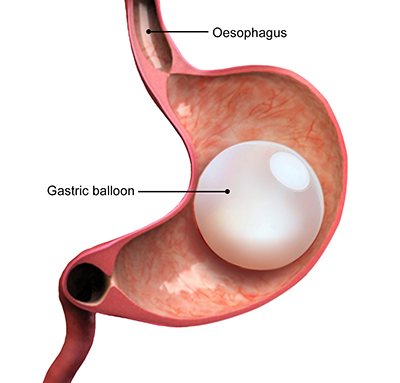Intragastric Balloon

What is Intragastric Balloon?
Gastric balloon, also called endoscopic intragastric balloon, is a non-surgical weight-loss procedure that involves the insertion of a specialised balloon inside the stomach to occupy space and limit the food-carrying capacity of the stomach. This makes you feel full sooner and limits your intake to smaller portions. The procedure is temporary, and the balloon is usually removed after a period of 6 months.
The expected weight loss is approximately 15-20% of excess body weight at 6 months *.
* Individual results may vary. Refer to our disclaimer
Indications and Contraindications of Intragastric Balloon
Intragastric balloon is a treatment option for those individuals who are unwilling to undergo weight-loss surgery despite meeting the medical necessity. In addition, the gastric balloon is also indicated in the following patients:
- They fall outside the existing criteria for bariatric surgery
- High surgical risk/poor general health
- To be used in conjunction with a medically-supervised dietary, lifestyle and behaviour modification program to enhance the degree of weight loss
The weight-loss system is contraindicated in the following patients:
- Have previously undergone stomach surgery
- Are suffering from inflammatory diseases of the GI tract, large hiatal hernia, structural abnormalities in the pharynx or oesophagus, and are prone to upper GI bleeding
- Any bleeding disorders
- Severe liver disease
- Alcoholics or drug abusers
- Allergy to materials used during the procedure
- Women who are pregnant, plan to become pregnant or breastfeeding
- Any other contraindications to endoscopy
Intragastric Balloon Procedure
The placement of the gastric balloon is carried out as an outpatient procedure.
The procedure is performed endoscopically under sedation. The deflated gastric balloon is attached to an endoscope (a narrow-illuminated tube with a camera attached) which is guided through your mouth and into the stomach. Once in proper position, your doctor inflates the balloon with saline and a dye to the desirable size. While the endoscope is removed, the balloon is retained in the stomach. The entire procedure takes about 15 minutes to complete. You will be able to leave the hospital soon after.
The balloon is temporarily left in the stomach for about 6 months, following which it is removed. The removal of the gastric balloon is also performed under sedation with an endoscope.
Post-Operative Care for Intragastric Balloon
Following the procedure, your throat might feel a little sore and you may experience some cramps and nausea as you adapt to the balloon being in your stomach. There are a number of medication options to help control the nausea. Small amounts of liquid can be commenced at a few hours after the procedure.
You will be on a liquid diet for the first week and then puree or soft diet for 2 weeks after. There will need to be follow-up with your surgeon and dietitian at the initial stages of your transition back to a normal diet. You will be guided towards eating the right type and amount of food which will ultimately influence the success of your procedure.
Risks and Complications of Intragastric Balloon
The Gastric balloon procedure is generally safe, but as with any procedure complications may occur and can include:
- Stomach (Gastric) or duodenal ulcers causing bleeding
- Deflation of the balloon which can sometimes lead to intestinal blockage
- Mallory-Weiss tear (in the lining of the lower oesophagus)
- Heartburn/reflux disease (Reflux oesophagitis)
- Abdominal pain, nausea and vomiting leading to dehydration
* Intragastric Balloon is designed to be remained in the stomach for 6 months according to the manufacturer’s recommendation. After this time, there is an increasing risk of balloon rupture as it is left in for longer.
* If the balloon ruptures, the blue dye used to inflate the balloon will be absorbed in the bowel and then released in the urine. When you notice a green discoloration in your urine, you need to notify your surgeon in order to arrange for the prompt removal of the balloon.
